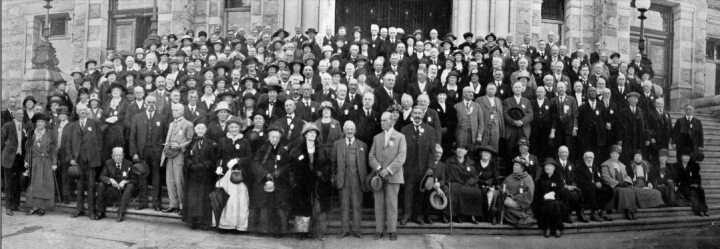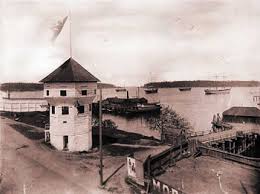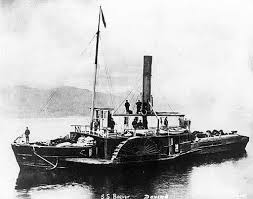#3 When Nanaimo was Colville
“Nanaimo was a mining hamlet of some forty-five buildings in 1857. The name was scarcely known outside Vancouver Island… The Beaver came along about every six months, the Otter more frequently, and an Express canoe occasionally… The chinks between the logs, through which the wind would sough with a shriek of triumph, were plastered up with clay or stuffed with moss.” — Nanaimo remembered, by Mark Bate
First Published: January 27th, 2016
Four-time Nanaimo mayor Mark Bate is at the centre of this 1924 gathering on the steps of the B.C. Legislature
The Second Annual Report and Proceedings of the British Columbia Historical Association in 1924 records how 250 “Pioneers” of B.C. were feted at an Empress Hotel banquet and dance hosted by MLA Dr. J.D. MacLean, a job befitting his title as honourary chair of the Historical Association. The report begins by noting MacLean was a Greenwood physician before entering politics just prior to World War I. By 1927 he would be Premier of B.C. “I wish to say,” Dr. J.D. MacLean remarked, “that the Historical Society of British Columbia and the Posts of Native Sons and Native Daughters of British Columbia are entitled to all congratulations on the magnificent success which they have made of this Pioneers’ Reunion. It is a rare thing—probably it has never happened in the history of any country—to have 250 guests who have been here for fifty-three years and upwards gathered under one roof. It is a magnificent tribute, first of all, to the loyalty of these pioneers; secondly, it is probably as equally great a tribute to the magnificent physiques which have permitted these men and women to travel, some of them several hundreds of miles, to he present at this reunion.”
The man who responded for the Pioneers was Mark Bate, who had arrived in Nanaimo in 1857 at the age of nineteen. Bate had served as a four-time mayor of that city (1875-1879, 1881-1886, 1888-1889, and 1898-1900), founder of the Nanaimo Literary Institute, and president and conductor of the Nanaimo Brass Band.
An edited version of Mark Bate’s speech on the early days of Nanaimo is reproduced below.
“To be so honoured at this, the first festive reunion of British Columbia Pioneers, is very gratifying,” Bates said. “There are occasions when we may count ourselves happy beings, and this great gathering of Pioneers certainly is one of them. It was a happy thought, whoever conceived it, to arrange this useful fraternal meeting—to bring together for right royal entertainment hundreds of Pioneers from different parts of the Province—give them an opportunity to come face to face, and renew old, or make new, acquaintances. A noble idea, truly, to my mind, and I think all present will agree with me.
“While I am fairly well acquainted with other cities and with many of their oldest inhabitants, if I should have a bit extra to say of Nanaimo and the first settlers there, it will be for the reason that I am familiar with that place and its people. I had supposed, before seeing the programme for to-night, that others present would follow me with interesting reminiscences of the sections they hail from and of their dwellers. My impression was wrong, it seems.
“What of the Pioneers—the men who have resolutely played their part in the upbuilding of this glorious Province? I landed at Victoria on Sunday, the 18th day of January, 1857. On getting into port, Captain Trivett, of the Princess Royal, his officers and passengers, were warmly greeted by the Chief Traders and staff of the Hudson’s Bay Company.”
Bate quoted an article from the Colonist:
“Who in Victoria remembers the arrival of the Princess Royal from England on the 18th day of January, 1857, bringing as passengers Miss Robinson, Miss Bate, Miss Harcus, Dr. Benson, John Coles, Mark Bate, Cornelius Bryant, John Kennedy, John Hall, Henry Wain, wife and child, James Marwick, wife and two children, Mrs. Marryman, and Peter Irvine? These persons were assuredly pioneer stock, some of whose descendants reach the fourth generation and are doing their share in peopling the Province to-day. John Coles was a naval lieutenant, who had been out years before on H.M.S. Thetis. He came to Victoria at this time hoping to marry Miss Mary Langford, but didn’t. Captain Herbert C. Lewis did. A few years later Lieutenant Coles married Miss Harcus, who was a niece of Captain Reid. The Coles lived at Saanich some time. John Kennedy was a son of Dr. Kennedy, then member for Nanaimo of the Legislative Assembly.
“John Hall was the Victoria Constable. He had been to England for a wife and came back without one, as he said, because he could not get the girl he wanted to accompany him out here. She was willing to marry him if he would remain in England. This proposition he declined. An amusing story was told of Mr. Hall. A Captain Mills had brought the barque Colinda out from London, put into a South American port on the way, and there illegally disposed of some ship’s stores. He was tried and convicted of the offence and given into the custody of Hall for imprisonment in the Bastion. The prisoner was allowed out on parole on certain days, returning at a stated hour for incarceration. One day he was quite late; the Constable became impatient, and, when the culprit turned up, told him if was late again he would “lock him out.”
Bate continued, recalling some of the outstanding citizenry of early Vancouver Island and revealing the extent to which the early white settlers of Vancouver Island were closely connected.
“During some twelve days’ stay in Victoria I had the pleasure of meeting and getting acquainted with many of those connected with the Hudson’s Bay Company and its affairs, all of whom were affable and accommodating gentlemen. I met John Work the elder, several times, covered with a heavy Inverness cape and carrying a skookum walking-stick. He was rather, though kindly, inquisitive—agreeable always.
“The Governor’s Private Secretary, Richard Golledge, rendered me some service, and I did not forget it when, many years afterward, I was in a position to serve him. I can in my mind’s eye see Captains Dodd, McNeil, Mitchell, Swanson, and Sangster; the Rev. Mr. Cridge, Dr. Tolmie, Dr. Johnson, and Dr. Helmcken; Mr. Roderick Finlayson, Mr. J. W. McKay. Judge Cameron, and many others. I had the pleasure of visiting the home of Judge Cameron at Belmont, Esquimalt, and partaking of a delicious cup of tea with Mrs. and Miss Cameron. I have noticed in one or two of the histories of British Columbia Judge Cameron is mentioned as having been manager, or in some office, at Nanaimo. This is a mistake. Mr. Cameron never lived in Nanaimo, nor did he hold office there. He was the book-keeper, with the help of a clerk, for the “ Nanaimo Establishment.” The books were sent by canoe from Nanaimo to Esquimalt to he written up, etc. My first job in the office of the Hudson’s Bay Company was copying Mr. Cameron’s books for transmission to London. I am one of those persons who believe we should never forget the names of any of these Fathers of our country. Some of those I have mentioned were here at the founding of the Fort.”
Bate reminded the gathering that the coal mining centre of Nanaimo was originally known as Colville. He recalls those who had arrived on ships in 1852, 1853, 1854 and 1857.
“These were the people who, as the first settlers, had gone into the wilds and endured hardships and privations that only those who shared them can realize. They found a dense wilderness, but were equal to the situation. They set to work with courage and cheerfulness: steadfastly held, as some of them said, a hungry hope for the good time coming.
“To one of them, assuredly, the “good time“ did come—the Honourable Robert Dunsmuir. They told how roughly the houses were constructed—of the dreary look outside and cramped space inside. How the chinks between the logs, through which the wind would sough with a shriek of triumph, were plastered up with clay or stuffed with moss; of the interior equipage of benches, boards, and bunk-like bedsteads; of the Dutch oven for baking and cooking; of the drugget rush mats and rugs, made, in part, of dog’s hair by Indians, used for floor-covering.
“Yet in 1857 there was a brightness, a warmth of feeling in every abode, made so by the blithesomeness, the inborn good nature, and the hospitality of inmates who, when visitors dropped by would:
Spread out the snowy table-cloth
Upon the painted board
And bring the best of everything
The larder could afford.
“That is how I found them after their years of splendid isolation among the timber and stumps of Colville Town. These were the dauntless class of men and women who went before to clear the way for others to follow. To-day their children’s children are going in the footsteps of their fathers—striking out for themselves.
“Nanaimo was a mining hamlet of some forty-five buildings in 1857, to which may be added the Indian camps. The name was scarcely known outside Vancouver Island and the precincts of the Hudson’s Bay Company’s offices in London. The place was well-nigh a terra incognita. Away from any channel of communication, weeks elapsed without ‘news from home’ —news which was the sweetener of a lonely existence. Postage of a half-ounce letter to the Old Country was 30 cents, and yet how gladly was an opportunity embraced to send a letter off, and with what ecstasy a letter or newspaper was received.
“The Beaver came along about every six months, the Otter more frequently, and an Express canoe occasionally. But ere two summers had passed, what a change! Toot! Toot!! Toot!!! We were suddenly enlivened after what seemed the quietude of years. Ocean steamships twice a month or more. River-steamers three or four times a week, with hundreds, yea, thousands of eager gold-seekers on the way to Fraser River. This was the period of the Fraser gold excitement with all its attendant effects, when hardy pioneers of California and an impetuous host from other countries made a rush for the placer diggings of New Caledonia.
“On entering the harbour, the Beaver, slowly and cautiously, as was her custom, made her way to an anchorage near the entrance to Commercial Inlet. There was no wharf at which to tie. Good old Beaver! Twenty years before she had been the first steamer to paddle the Pacific Ocean, which now bears on the bosom of its foam-crested waves a mighty, yet steadily increasing commerce. The whole inhabitants nearby were descried on a hillside, curious, maybe, to get a look at the new-comers. Once ashore the heartiness of welcome from all was something never to he forgotten.
“In November 1854, twenty-two families arrived by the Princess Royal from England for Nanaimo. A few of them are still there. From this sturdy stock Nanaimo, I think, possesses the greatest number of British Columbia Pioneers. The anniversary of the Princess Royal’s arrival is appropriately celebrated by Nanaimo-ites every year—never forgotten.”
Information on Mark Bate is from Jan Peterson’s A Place in Time: Nanaimo Chronicles published by the Nanaimo Museum.
This article is part of an ongoing series of looks into the Rear View Mirror of the past that is presented by our colleagues at British Columbia History, the province’s most venerable literary periodical, dating back to 1937. As the journal of the B.C. Historical Federation, BCH is published quarterly in March, June, September and December. It provides feature-length articles as well as documentary selections, essays, pictorial essays, memoirs, and reviews relating to the social, economic, political, intellectual, and cultural history of British Columbia. British Columbia History began in 1923 as the Annual Report and Proceedings of the British Columbia Historical Association (now the British Columbia Historical Federation). From 1937-58 it was published as the British Columbia Historical Quarterly. From 1965-2005, it was called the BC Historical News. The BCHF is fortunate to have the support of the UBC Library in digitizing the back issues of its publications and supporting the stewardship of these important links to the past (available here).
Subscriptions to British Columbia History are managed by the Magazine Association of BC. To subscribe for $20 per year, visit the journal at http://www.bchistory.ca/publications/journal/ or email subscriptions@magsbc.com or send a cheque to #201-318 Homer St., Vancouver, BC V6B 2V2.
For book reviews or queries related to British Columbia History, contact K. Jane Watt at magazine@bchistory.com . For its editor Andrea Lister, contact bcheditor@bchistory.com.




